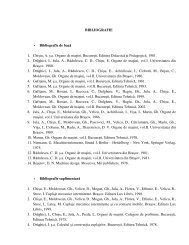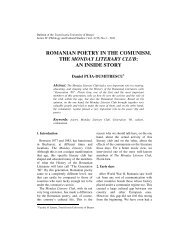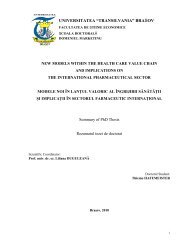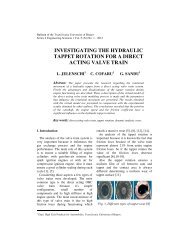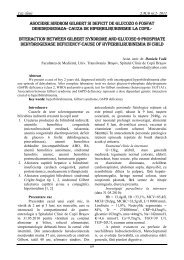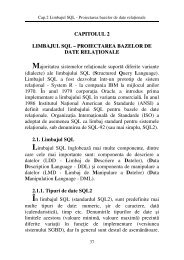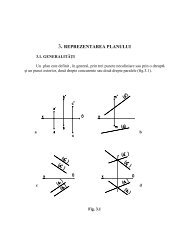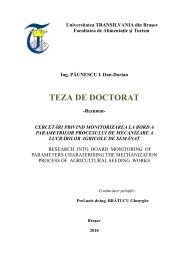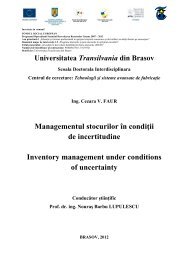TRACING ZERLINA'S ANCESTORS
TRACING ZERLINA'S ANCESTORS
TRACING ZERLINA'S ANCESTORS
Create successful ePaper yourself
Turn your PDF publications into a flip-book with our unique Google optimized e-Paper software.
Bulletin of the Transilvania University of Braşov<br />
Series VIII: Art • Sport • Vol. 5 (54) No. 2 - 2012<br />
<strong>TRACING</strong> ZERLINA’S <strong>ANCESTORS</strong><br />
Mihaela BUHAICIUC 1<br />
Abstract: The purpose of this article is to identify in the theater and opera<br />
early literature the ancestors of Zerlina’s character from the opera Don<br />
Giovanni by W.A. Mozart. By doing so, I emphasize the importance of indepth<br />
knowledge of opera characters prior to any attempt to performing<br />
them.<br />
Key words: Zerlina, Don Giovanni, Da Ponte, Mozart, ancestors .<br />
1. Introduction<br />
No characters of any operas create more<br />
vividly the impression of being real<br />
people of the time as Mozart’s figures do<br />
in his operas: the Count and the Countess,<br />
Suzanna and Figaro, Zerlina and Masetto,<br />
Leporello and Despina, to name a few.<br />
Mozart’s imagination went beyond the<br />
en-voque stereotypes of opera buffa and<br />
created not simple figures going through<br />
conventional, superficial aspects of their<br />
current daily life, nor social types<br />
integrated in the eighteen century political<br />
frame, but human beings, each of them<br />
feeling, speaking and behaving under<br />
certain circumstances very much as any<br />
other human being would, whether in the<br />
eighteen century or the twenty first.<br />
Did Mozart have his favorites? He did,<br />
indeed. He was a sympathizer of the<br />
peasants and the servants. He himself was<br />
one of them. Therefore, the roles he<br />
allocates to his servants are significant<br />
parts. They care the action and the<br />
intrigue. They bring on-stage the humor<br />
through different comic elements. They tell<br />
the story. One may find in them the<br />
composer himself. In Mozart’s operas, the<br />
low-class characters seem to be those with<br />
the common sense, those who oversee the<br />
situation, those who objectify and adjust<br />
their situation so it meets their interest.<br />
These people are sincere. They behave<br />
how they feel. They have more lifewisdom<br />
and humor than their counterparts:<br />
the high-class personages. Their definition<br />
for life is reality. Their morals is perhaps<br />
different than aristocracies’ but they do<br />
distinguish between good and wrong, evil<br />
and divine. They perhaps don’t have a<br />
wide knowledge, but they have belief.<br />
Lorenzo Da Ponte furnished the libretto<br />
for Mozart’s opera. Its title is: Il dissolute<br />
punto, ossia il Don Giovanni – The<br />
Libertine punished or Don Juan.<br />
Writers and poets have been used the<br />
ancient Don Juan legend starting with the<br />
early seventeenth century: Tirso De<br />
Molina, Molière, Shadwell, Goldoni,<br />
Bertati, Byron, Lenau - whose poem<br />
inspired R. Strauss - and Shaw, among<br />
others. Most of authors keep the characters<br />
and the action related to the original play:<br />
Tirso De Molina’s El Burlador de Sevilla y<br />
convidado de piedra, written in 1630.<br />
1 Faculty of Music, Transilvania University, Braşov.
78<br />
Bulletin of the Transilvania University of Braşov • Series VIII • Vol. 5 (54) No. 2 - 2012<br />
Some character names are changed<br />
accordingly corresponding to the place of<br />
the action. For instance, Molière’s<br />
protagonists are French: Charlotte and<br />
Pierrot, Bertati’s characters are Italian:<br />
Maturina and Biagio.<br />
2. Tirso de Molina’s Tisbea<br />
Zerlina’s first ancestor is De Molina’s<br />
Tisbea. By her demeanor and actions,<br />
Tisbea becomes the most intriguing and<br />
interesting female character in El Burlador<br />
de Sevilla y convidado de piedra. She<br />
represents the traditional mythical type<br />
modeled on the disdainful shepherdess<br />
figure of the sixteenth century pastoral<br />
stories. She is beautiful, but not sociable,<br />
aloof from many male admirers. Her real<br />
fascination sits in her individuality. What<br />
captures our attention are the<br />
contradictions in her character and the<br />
powerful passion, which boils under her<br />
beauty. We notice her delight in the<br />
sufferings of her suitors; delight, which<br />
comes not from her indifference, but from<br />
her trust in herself and her belief that she,<br />
controls the situation. Tisbea finds it<br />
difficult to resist Don Juan’s pursuing.<br />
Abandoned by Juan, after he promised to<br />
marry her, Tisbea degrades beyond<br />
desperation. Juan’s betrayal pushed her to<br />
attempt suicide. Tisbea’s outrage and<br />
excessive violence come from a conscious<br />
downfall, not from self-pity awareness as a<br />
victim of Don Juan’s perfidy. She<br />
continues to live but conducted by a new<br />
motto: all men are not to be trusted. Even<br />
more disturbing thought for her, to which<br />
she has not found the answer remains: in<br />
given circumstances, can she trust herself?<br />
3. Tirso de Molina’s Aminta<br />
Another peasant character, which I have<br />
been initially taken as one of Zerlina’s<br />
ancestors in De Molina’s El Burlador de<br />
Sevilla y convidado de piedra. is Aminta.<br />
Unlike Tisbea, Aminta is psychologically<br />
less complex. She is a naïve country girl,<br />
who is flattered and overwhelmed by Don<br />
Juan’s attentions. Generally, Aminta seems<br />
more honest than any other woman in the<br />
De Molina’s play. She simply gets<br />
annoyed when Batricio, her fiancé, reacts<br />
unfavorably to Don Juan’s arrival. Aminta<br />
protests when Don Juan enters in her<br />
bedroom at night. Although flattered by his<br />
words, Aminta’s good sense tells her not to<br />
trust him. She accepts his offer for<br />
marriage but only after the Don convinces<br />
her that Batricio has abandoned her.<br />
Aminta could possibly represent<br />
Zerlina’s direct correspondent in De<br />
Molina’s play. One of the reasons could be<br />
the fact that the wedding scene from the<br />
play, No.7, corresponds with scene No. 5<br />
in Da Ponte’s libretto. Nevertheless,<br />
Aminta is not created as a sharp and<br />
interesting peasant girl. Tisbea embodies<br />
those features. In the whole setting of the<br />
play Aminta remains a pale figure, unlike<br />
Tisbea, whose characteristics are clearly<br />
portrayed. This is the main reason for<br />
which Tisbea is considered the first Zerlina<br />
in the literature.<br />
4. Andrea Cicognini’ Rosalba<br />
The earliest Italian version of Don<br />
Giovanni plays is Il Convitato di pietra<br />
written probably in 1632 by Giacianto<br />
Andrea Cicognini. His play is based on the<br />
De Molina’s El Burlador de Sevilla y<br />
convidado de piedra and follows closely<br />
the action, which takes place this time in<br />
Italy: Naples and Castile. Cicognini keeps<br />
most of Tirso De Molina’s characters. We<br />
find Tisbea in Rosalba, a fisher woman,<br />
who saves Don Giovanni from the sea. She<br />
is added to Don Giovanni’s catalogue of<br />
conquests, fact not mentioned in Juan’s list<br />
from El Burlador de Sevilla y convidado<br />
de piedra. Although she follows the action,
M. BUHAICIUC: Tracing Zerlina’s Ancestors 79<br />
which Tisbea cares in De Molina, in<br />
Andrea Cicognini’s play, Rosalba does not<br />
resembles Tisbea’s personality, being<br />
portrayed as a weak figure in the play.<br />
5. Carlo Goldoni’s Elisa<br />
Another Italian version of Don Giovanni<br />
written one hundred years later, in 1736, is<br />
Carlo Goldoni’s Don Giovanni Tenorio or<br />
The Dissolute Man. The action of the play<br />
takes place in Castile and in the<br />
surrounding countryside. The noble<br />
characters are similar in features with those<br />
from earlier plays, except Elisa, a Castilian<br />
shepherdess and Carino, her lover. In<br />
Goldoni’s play, Elisa is as complex, strong<br />
and interesting as Tisbea is in De Molina’s<br />
El Burlador de Sevilla y convidado de<br />
piedra.<br />
Elisa appears on stage in the second act<br />
with her lover Carino. They swear each<br />
other fidelity for life. In the next moment,<br />
when left alone on stage, Elisa encounters<br />
Don Giovanni. Her mind and heart are<br />
changed once again. If Tisbea was more<br />
reserved in her manners, yet sincere, Elisa<br />
is a betrayer. Her purpose is to only enjoy<br />
herself and obtain a better social position.<br />
She pretends to love anyone who would<br />
offer her a better status. Elisa even begs<br />
Don Giovanni to marry her as soon as<br />
possible with the excuse that tomorrow she<br />
might have another offer.<br />
In comparison with Tisbea’s attempt to<br />
commit suicide, Elisa’s simulation of<br />
dying is only a trick to keep her lovers<br />
around.<br />
6. Gazzaniga-Bertati’s Maturina<br />
With eight months before Mozart’s Don<br />
Giovanni was performed, Giusseppe<br />
Gazzaniga presents in 1787, in Venice Il<br />
Capricio Dramatica, an opera in two acts.<br />
The first act is a prolog to Don Giovanni, o<br />
sia il convitato do pietra, which itself is a<br />
drama giocoso in one act. Bertati’s libretto<br />
is very close to Da Ponte’s. Zerlina’s and<br />
Masetto’s correspondents are Maturina and<br />
Biagio. The two young peasants are having<br />
their wedding, to which Don Giovanni<br />
shows up. Attracted by his charm, his<br />
words and convinced by his promise to<br />
marry her, Maturina accepts Don Giovanni<br />
in her house. What she is not aware of yet<br />
is that this Don is aggressive, even more<br />
than Da Ponte’s Giovanni. In this play,<br />
Don Giovanni slaps and beats Biagio in<br />
front of Maturina’s eyes. Even after Biagio<br />
is beaten, Maturina considers Don<br />
Giovanni a potential husband, who might<br />
offer her a change in her life. Unlike<br />
Tisbea and Elisa, Maturina is not as direct<br />
in her thought and feeling deliverance. She<br />
does not communicate directly to her stage<br />
partners. We understand her feelings from<br />
her actions. The contradictions in her<br />
character are not well defined. Hermann<br />
Albert makes a remark in his book<br />
Mozart’s Don Giovanni regarding the<br />
singers of Maturina and Biagio in<br />
Giusseppe Gazzaniga’s opera, Il Capricio<br />
Dramatica. The soprano, who plays<br />
Maturina’s role, also sings Donna Anna;<br />
and Biagio’s interpreter also performs the<br />
Commander’s part in the same<br />
performance. Maturina never meets Donna<br />
Anna in this opera.<br />
7. Molière’s Charlotte<br />
Molière’s Don Juan ou le Festin de<br />
Pierre was written in 1665, only thirty-five<br />
years after Tirso de Molina’s El Burlador<br />
de Sevilla y convidado de piedra.<br />
Molière’s play was not based directly on<br />
De Molina’s work. In fact, I have found<br />
the two plays very different. Molière’s<br />
Don Juan is more sophisticated. He<br />
represents a “thoughtful” - seducer rather<br />
than a man of action. Molière has<br />
embodied in his protagonist the type of the<br />
libertine and the religious skeptic, who
80<br />
Bulletin of the Transilvania University of Braşov • Series VIII • Vol. 5 (54) No. 2 - 2012<br />
likes to follow his own rules in life,<br />
assuming all risks and discounting any<br />
costs. We find Zerlina in Molière’s<br />
Charlotte, a peasant teenager, whose<br />
fiancée does not understand her love for<br />
him. As Tisbea, Charlotte is full of<br />
contradictions. She loves Pierrot, but if she<br />
is displeased from any reason, she’ll go for<br />
someone else. She is not begging for<br />
attention. However, she gets it. When this<br />
comes from Don Giovanni, Charlotte feels<br />
embarrassed, not because he’s just another<br />
man, but a noble one. His interest and<br />
attraction to her does make her feel quite<br />
special. Caught in Giovanni’s game,<br />
Charlotte enjoys herself. When asked to<br />
seal the engagement with a kiss, Charlotte<br />
protects her honor refusing him.<br />
8. Mozart-Da Ponte’s Zerlina<br />
The next Don Giovanni appears in<br />
Mozart’s opera with the same name, first<br />
performed in 1787. Mozart’s characters<br />
bring together different elements from<br />
earlier versions of the story. Da Ponte’s<br />
libretto is a synthesis of Tirso de Molina’s<br />
El Burlador de Sevilla y convidado de<br />
piedra and Molière’s Don Juan ou le<br />
Festin de Pierre. The personage of Don<br />
Giovanni retains the passion of De<br />
Molina’s character as well as the<br />
sophistication of Molière’s Don Juan.<br />
Nevertheless, Mozart’s protagonists are<br />
closer to Molière’s figures.<br />
Mozart’s women are portrayed with<br />
great sympathy often with indignant pity.<br />
The sentimental public sees them as<br />
innocent victims. In his book The Theater<br />
of Don Juan, Mandel assimilates Zerlina to<br />
Ximena from Bertati’s play.<br />
Lorenzo Da Ponte gives Zerlina an<br />
innocent grace and a natural impulsiveness<br />
as a simple country girl. Musically, Mozart<br />
highlights her features: beauty, sensuality,<br />
and sometimes conflicted. Da Ponte and<br />
Mozart did not create Zerlina as a super<br />
woman, outdoing dramatically Donna<br />
Anna and Dona Elvira. Nevertheless, she<br />
complements their function and highlights<br />
Don Giovanni’s. Each character has its<br />
own psychological development<br />
throughout Mozart’s opera, so does<br />
Zerlina. She changes moods and feelings.<br />
Her will is weak due to her youth. But her<br />
lesson is learnt. Her occasional humoristic<br />
element in the scenes with Masetto is the<br />
ingredient needed in Giovanni’s drama,<br />
added as a last cherry on the cake’s top.<br />
Zerlina’s character balances dramatically<br />
the action. Her music is painted with<br />
Mozartian clarity and beauty.<br />
9. Conclusion<br />
The names of the peasant girls seduced<br />
by Don Giovanni in the plays briefly<br />
discussed here are symbolic. They<br />
represent the ones, who come out of the<br />
crowd and whose interest is to rise above<br />
it. Molière has expressed this clearly in<br />
Charlotte’s name, which literally means<br />
“pudding”. In Spanish, Tisbea’s name has<br />
a sweet light resonance and inspires trust.<br />
Elisa’s name, too elegant for a provincial<br />
denotes her sharp demeanor. The closeback<br />
vowel “u” in Maturina’s name<br />
suggests a slight different conduct than<br />
Tisbea’s and Elisa’s. Zerlina’s name has<br />
the most feminine expression. She<br />
embodies the woman, who reasons by<br />
feeling.<br />
Created by Da Ponte and brought to life<br />
by Mozart, Zerlina remains in the universal<br />
literature a symbol of woman’s simplicity,<br />
innocence, determination and sensuality.




